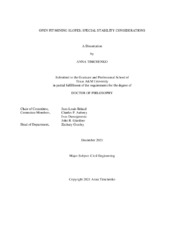| dc.description.abstract | Slope stability analysis and design are important in mining geotechnical engineering, as open-pits have slopes cut as steep as possible to ensure efficient mining. We must mine the ore while keeping the total waste to a minimum, aiming for a reasonable factor of safety (FS) and tolerable probability of failure (PoF). Therefore the safety issues along with economic issues should be taken into consideration during the mine slope design.
In order to tackle this problem, the researcher focused on the following three objectives: (a) to develop solutions to predict the debris travel distance for improved management and repairs, the setback distance for equipment at the top of the slope, and a stability chart for preliminary selection of the slope angle, based on a large open-pit slope failures collection; (b) to compare the two-dimensional (2-D) and three-dimensional (3-D) slope stability methods to obtain the FS; (c) to compare the slope behavior at corners and in plane strain.
The first objective was accomplished based on published evidence. The researcher created the TAMU-MineSlope Spreadsheet including 134 open pit slope failures that occurred at 60 mines worldwide. Analysis by an energy principle approach along with the TAMU-MineSlope data analysis allowed us to come up with the best prediction equation for the debris travel distance LTRAV: LTRAV(m)=1.75· HFALL (m)∕ tanφ where HFALL is the vertical distance from the crest of the failure to the end of the debris flow tongue. Also based on the case histories analysis, the best setback distance equation was found to be: LSB(m) = HFAIL 0.82(m), where HFAIL is the vertical distance from the crest of the failure to the toe of the slip surface. The researcher reviewed and evaluated the existing stability charts (Taylor’s, Hoek&Bray’s) and proposed a new one as part of this research. The proposed chart can be used for the preliminary design of open-pit slopes. Finally, the researcher updated the f-n chart presented by Whitman in 1981 and advocate that risk values of 0.001 fatalities/year and $10,000/year are reasonably tolerable as they are consistent with other daily human activities tolerated by the general public.
To address the second objective, the researcher compared the FS obtained by the 2-D and 3-D slope stability methods. The numerical simulation results showed that the 3-D analysis must be performed for slopes with W/H<4 where W is the width of the failed soil mass and H is the height of the slope. It was shown that the minimum 3-D FS is greater than the minimum 2-D FS for all conditions considered herein. It was shown that the parameters that have the greatest significant influence on the FS are the slope geometry and the cohesion rather than the friction angle. The FS and PoF acceptance criteria in open-pit mining design were also discussed. Acceptable values were found to be FS=1.3 and PoF<0.05-0.3 for mining slopes; these values are much higher than the values commonly employed in civil engineering (PoF<0.001).
To address the third objective of the study, the researcher studied the factor of safety for complicated open-pit wall geometries (concave- or convex-shaped corners). The researcher simulated numerically the behavior of 3-D slopes using the RS3 software (Rocscience Inc.). The results show that the displacement-based approach is more effective in determining the corner stability than the traditional FS approach. The researcher showed that the displacement is inversely proportional to the FS. Furthermore, the sharp convex corner FS is up to 40% lower than the plane strain case, while the sharp concave corner is up to 3 times greater than the plane strain FS. Lastly, with the increase of the radius of curvature, the difference between the corner stability and plane strain case is decreasing with an increase in the plan view radius of curvature. The researcher reviewed the influence of benching for slope stability and showed that for materials with low cohesion, the use of benching is not useful. As for the effect of water level fluctuation, our research findings show that the lowest factor of safety is reached when the water level is at 40% of the slope height. | |


